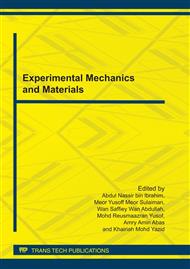p.35
p.41
p.48
p.54
p.60
p.66
p.73
p.78
p.85
Dynamic Response of Magnesium Alloy AZ31B under High Strain Rate Compressive Loading
Abstract:
Magnesium alloys have been increasingly used in automobile, aerospace, consumer electronics and communication industries due to their low density, high strength to weight ratio, good impact resistance and castability. Impact situations in vehicles and airplanes and high speed metal working are characterized with the high rates of loading. The dynamic properties of materials are critical to evaluate the materials’ response in impact situations. They are also useful to design various automotive and aerospace components that are subjected to high rates of loadings. In current study, the compressive behaviour of magnesium alloy AZ31B has been examined over a wide range of strain rate between 103 and 3x103 s-1 in order to evaluate its potential in structural applications. Higher stresses are observed at higher strain rates. The peak stress increases about 10% for an increase in the strain rate from 980 s-1 to 2450 s-1. The hardening exponent n increases from 0.65 to 0.72 with increasing strain rate from 980 s-1 to 2450 s-1 indicating that the alloy is rate sensitive. However, the rate sensitivity of the alloy is negligible at lower strains and is significantly higher at higher strains. Energy absorption during deformation in general is increased with the strain rate.
Info:
Periodical:
Pages:
60-65
Citation:
Online since:
July 2011
Authors:
Price:
Сopyright:
© 2011 Trans Tech Publications Ltd. All Rights Reserved
Share:
Citation:


